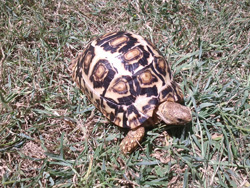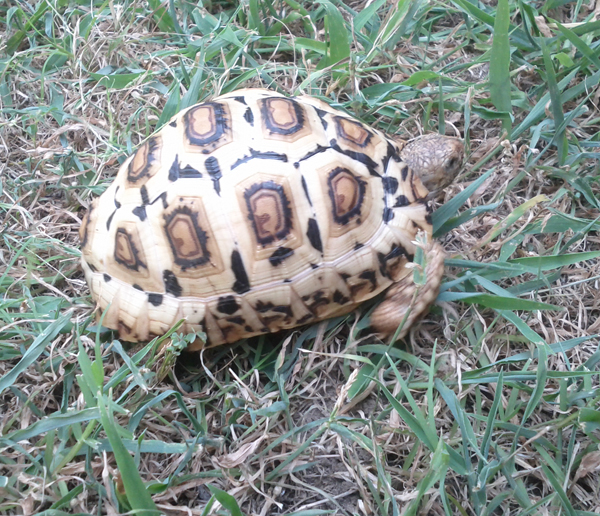Leopard Tortoise Profile
 The African Leopard Tortoise (Stigmochelys pardalis) is a native species found predominantly in the savannahs and grasslands of north eastern all the way down to the southern parts Africa. They can be found ranging from Sudan to the southern tip of South Africa making them the most wide spread tortoise species on the continent of Africa and one of the most adaptable species in the world. In certain locals in South Africa, leopard tortoises have been reported to brumate (the equivalent of hibernate for mammals) over the winter months where temperatures can drop below freezing. Like most tortoises, the Leopard tortoise is very long lived animal where in optimal condition can live over 100 years.
The African Leopard Tortoise (Stigmochelys pardalis) is a native species found predominantly in the savannahs and grasslands of north eastern all the way down to the southern parts Africa. They can be found ranging from Sudan to the southern tip of South Africa making them the most wide spread tortoise species on the continent of Africa and one of the most adaptable species in the world. In certain locals in South Africa, leopard tortoises have been reported to brumate (the equivalent of hibernate for mammals) over the winter months where temperatures can drop below freezing. Like most tortoises, the Leopard tortoise is very long lived animal where in optimal condition can live over 100 years.
The leopard tortoise is a large tortoise and ranks as the forth largest in the world behind the Galapagos (Chelonidis nigra), Aldabra (Aldabrachelys gigantea), Sulcata (Centrochelys sulcata) and the second largest in mainland Africa to the massive Sulcata. Their size does vary according to localities in their natural range with the largest specimens coming from Ethiopia, the humid region of Sudan and South Africa where they can reach a weight of 120 pounds and plastron length of 30 inches or more. Typical adult specimens found in the pet trade in the U.S. range from 13 inches to 18 inches and weigh around 20 to 40 pounds originating from Kenya. Males from this region are considerably smaller than females. Kenya was a big exporter in leopard tortoises for the pet trade in the late ’80s and ’90s. In the U.S. there is however, a healthy population of South African leopard tortoises available in the pet trade and show a few distinguishing features between those leopard tortoise from Kenya. If you are interested in obtaining a South African leopard tortoise be sure it is from a reputable breeder and the cost is typically double compared to a ‘normal’ leopard.
In appearance, the leopard tortoise is an attractive species with a golden to light beige carapace with dark brown/black spots as juveniles and young adults that can resemble rosettes similar to a great cat, the Leopard, thus given them their common name. These distinct markings on their carapace will fade to light brown or grey as they age giving them a more monotone appearance. They are considered a high domed tortoise species referring to the shape of their carapace. When looking at the profile of some specimens it can represent an upside down ‘U’. The skin color is cream or cream with speckles and will typically darken as they age. They walk with a slight ‘pigeon-toed’ gate and have five toe nails on their front legs and their back legs are stout with four toe nails. There have been reports that leopard tortoises are good climbers as far as tortoises go and they do feel comfortable in water and can swim across ponds and small lakes. Some can learn to float by trapping some air in their lungs thus enabling them to swim.

A typical captive juvenile leopard tortoise
Inhabiting mainly grasslands in their natural range, their diet consists of grasses, weeds, leaves, flowers and succulents. Leopard tortoises have been observed in the wild eating the droppings of carnivores (both lions and hyenas) and the theory is they are searching for calcium to supplement their diet. They are relatively fast growers in the tortoise world and their calcium requirements are substantial to keep pace with their growth. Sexual maturity is achieved based more on size than age. Faster growing individuals will reach sexual maturity sooner that slower growing individuals of the same age. In general it has been observed that the males needs to be around eight inches long and females closer to twelve. Again this can occur as soon as 6 years of age or as late as 15 years of age. Captive animals tend to grow faster on average than their wild counter parts due to optimal living conditions.
Once a female has reached sexual maturity, is producing eggs and has mated successfully, they will lay a clutch of 5 to 20 eggs multiple times through out the year with 3 clutches being most typical. The eggs can take from 4 to 14 months to hatch depending on a wide range of environmental variables. It was once believed by many hobbyists that all the hatchlings from the same clutch will have the same sex, that has been proven to be incorrect. However egg incubation temperatures can have an effect on the out come of hatchling sex. It has been reported that eggs incubated at the higher temperature range of 88 to 90 degrees Fahrenheit will increase the probability of females and eggs incubated at the lower ranges of 82 to 87 degrees Fahrenheit will produce males. More research needs to be conducted as the exact temperatures and as what phases of ovum development are the most crucial in determining sex.
Leopard tortoises are listed in the CITES Appendix II as a threatened species and in areas of high human habitation, they are viewed as a food source and are becoming increasingly scarce, however, in rural areas and national parks and game reserves, they maintain health populations. As of March 22, 2000 the USDA banned importation of leopard tortoises to the U.S. upon discovery that various imported specimens arrived with ticks that had been known to carry heartwater disease which can have a devastating effect on domestic cattle. Luckily both for the tortoise and hobbyist, they are relatively easy to breed in captivity thus ensuring their future as a species. Captive bred hatchlings, juvenals and up through breeding aged adults are readily available for purchase in the U.S.
